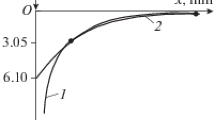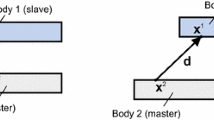Abstract
The numerical simulation of contact problems is nowadays a standard procedure in many engineering applications. The contact constraints are usually formulated using either the Lagrange multiplier, the penalty approach or variants of both methodologies. The aim of this paper is to introduce a new scheme that is based on a space filling mesh in which the contacting bodies can move and interact. To be able to account for the contact constraints, the property of the medium, that imbeds the bodies coming into contact, has to change with respect to the movements of the bodies. Within this approach the medium will be formulated as an isotropic/anisotropic material with changing characteristics and directions. In this paper we will derive a new finite element formulation that is based on the above mentioned ideas. The formulation is presented for large deformation analysis and frictionless contact.












Similar content being viewed by others
Notes
More complex material models (e.g. finite plasticity) will not change the approach followed within this paper. They will only yield more complicated equations to describe the material behaviour of the contacting bodies and thus are omitted for clarity of the new ideas.
Another possibility could be to interpolate between both strain energy functions \(W^M=(1-\gamma ) W^M_\mathrm{{iso}}+ \gamma \,W^M_\mathrm{{aniso}}\), where \(\gamma \) is connected to the approach (gap), thus \(\gamma =\gamma (g_n)\), with the idea to omit the isotropic part once the gap is small.
In case of friction two additional different structural tensors have to be defined that are associated with the tangents at the deformed surface of bodies \(\mathcal B ^\alpha \), e.g, \(\mathbf{M}_1^\alpha = \varvec{\varphi }^\alpha _{,1}\otimes \varvec{\varphi }^\alpha _{,1}\) and \(\mathbf{M}_2^\alpha = \varvec{\varphi }^\alpha _{,2}\otimes \varvec{\varphi }^\alpha _{,2}\) are defined.
References
Ball JM (1997a) Constitutive inequalities and existence theorems in nonlinear elastostatics. In: Knops RJ (ed) Symposium on non-well posed problems and logarithmic convexity. Lecture notes in mathematics. Springer, Berlin
Ball JM (1977b) Convexity conditions and existence theorems in nonlinear elasticity. Arch Ration Mech Anal 63:337–403
Betten J (1987) Formulation of anisotropic constitutive equations. In: Boehler JP (ed) Applications of tensor functions in solid mechanics. CISM courses and lectures. Springer, Berlin
Boehler JP (1979) A simple derivation of respresentations for non-polynomial constitutive equations in some cases of anisotropy. Z Angew Math Mech 59:157–167
Boehler JP (1987) Introduction to the invariant formulation of anisotropic constitutive equations. In: Boehler JP (ed) Applications of tensor functions in solid mechanics. CISM courses and lectures. Springer, Berlin
de Lorenzis L, Temizer I, Wriggers P, Zavarise G (2011) A large deformation frictional contact formulation using NURBS-based isogeometric analysis. Int J Numer Methods Eng 87:1278–1300
de Lorenzis L, Wriggers P, Zavarise G (2012) Isogeometric analysis of 3D large deformation contact problems with the augmented lagrangian formulation. Comput Mech 49:1–20
Ebbing V, Schröder J, Neff P (2009) Approximation of anisotropic elasticity tensors at the reference state with polyconvex energies. Arch Appl Mech 79:651–657
Fischer KA, Wriggers P (2005) Frictionless 2D contact formulations for finite deformations based on the mortar method. Comput Mech 36:226–244
Fischer KA, Wriggers P (2006) Mortar based frictional contact formulation for higher order interpolations using the moving friction cone. Comput Methods Appl Mech Eng 195:5020–5036
Flemisch B, Puso MA, Wohlmuth B (2005) A new dual mortar method for curved interfaces: 2D elasticity. Int J Numer Methods Eng 63:813–832
Hallquist JO (1979) Nike2d: an implicit, finite-deformation, finite element code for analysing the static and dynamic response of two-dimensional solids. Technical Report UCRL-52678. Lawrence Livermore National Laboratory, University of California
Hallquist JO, Goudreau GL, Benson DJ (1985) Sliding interfaces with contact-impact in large-scale lagrange computations. Comput Methods Appl Mech Eng 51:107–137
Hartmann S, Oliver J, Weyler R, Cante J, Hernández J (2009) A contact domain method for large deformation frictional contact problems. Part 2: numerical aspects. Comput Methods Appl Mech Eng 198:2607–2631
Krstulovic-Opara L, Wriggers P, Korelc J (2002) A \({C}^1\)-continuous formulation for 3D finite deformation frictional contact. Comput Mech 29:27–42
Labra C, Rojek J, Onate E, Zarate F (2008) Advances in discrete element modelling of underground excavations. Acta Geotech 3: 317–322
Laursen TA (2002) Comput Contact Impact Mech. Springer, Berlin
Morrey CB (1952) Quasi-convexity and the lower semicontinuity of multiple integrals. Pac J Math 2:25–53
Oliver J, Hartmann S, Cante J, Weyler R, Hernández J (2009) A contact domain method for large deformation frictional contact problems. Part 1: theoretical basis. Comput Methods Appl Mech Eng 198:2591–2606
Onate E, Idelsohn SR, Celigueta MA, Rossi R (2008) Advances in the particle finite element method for the analysis of fluid-multibody interaction and bed erosion in free surface flows. Comput Methods Appl Mech Eng 197:1777–1800
Padmanabhan V, Laursen T (2001) A framework for development of surface smoothing procedures in large deformation frictional contact analysis. Finite Elem Anal Des 37:173–198
Pietrzak G, Curnier A (1997) Continuum mechanics modeling and augmented lagrange formulation of multibody, large deformation frictional contact problems. In: Owen DR, Hinton E, Onate E (eds) Proceedings of COMPLAS 5. CIMNE, Barcelona, pp 878–883
Popp A, Gitterle M, Gee M, Wall WA (2010) A dual mortar approach for 3D finite deformation contact with consistent linearization. Int J Numer Methods Eng 83(11):1428–1465
Puso MA (2004) A 3D mortar method for solid mechanics. Int J Numer Methods Eng 59(3):315–336
Puso MA, Laursen TA (2004) A mortar segment-to-segment contact method for large deformation solid mechanics. Comput Methods Appl Mech Eng 193:601–629
Schröder J (2010) Anisotropic polyconvex energies. In: Schröder J, Neff P (eds) Poly-, quasi- and rank-one convexity in applied mechanics. CISM courses and lectures. Springer, Berlin
Schröder J, Neff P (2003) Invariant formulation of hyperelastic transverse isotropy based on polyconvex free energy functions. Int J Solids Struct 40:401–445
Schröder J, Neff P, Balzani D (2005) A variational approach for materially stable anisotropic hyperelasticity. Int J Solids Struct 42(15):4352–4371
Schröder J, Neff P, Ebbing V (2008) Anisotropic polyconvex energies on the basis of crystallographic motivated structural tensors. J Mech Phys Solids 56(12):3486–3506
Simo JC, Wriggers P, Taylor RL (1985) A perturbed Lagrangian formulation for the finite element solution of contact problems. Comput Methods Appl Mech Eng 50:163–180
Spencer AJM (1971) Theory of invariants. In: Eringen AC (ed) Continuum physics. Academic Press, New York
Temizer I, Wriggers P, Hughes TJR (2011) Contact treatment in isogeometric analysis with NURBS. Comput Methods Appl Mech Eng 200:1100–1112
Temizer I, Wriggers P, Hughes TJR (2012) Three-dimensional mortar-based frictional contact treatment in isogeometric analysis with NURBS. Comput Methods Appl Mech Eng 209–211: 115–128
Tur M, Fuenmayor F, Wriggers P (2009) A mortar-based frictional contact formulation for large deformations using lagrange multipliers. Comput Methods Appl Mech Eng 198:2860–2873
Wohlmuth BI (2000) A mortar finite element method using dual spaces for the lagrange multiplier. SIAM J Numer Anal 38: 989–1012
Wohlmuth B, Krause R (2004) Monotone methods on non-matching grids for non linear contact problems. SIAM J Sci Comput 25:324–347
Wriggers P (2006) Comput Contact Mech, 2nd edn. Springer, Berlin
Wriggers P (2008) Nonlinear finite elements. Springer, Berlin
Wriggers P, Krstulovic-Opara L, Korelc J (2001) Smooth \({C}^1\)- interpolations for two-dimensional frictional contact problems. Int J Numer Methods Eng 51:1469–1495
Wriggers P, Simo J (1985) A note on tangent stiffnesses for fully nonlinear contact problems. Commun Appl Numer Methods 1:199–203
Zavarise G, Wriggers P (1998) A segment-to-segment contact strategy. Math Comput Model 28:497–515
Author information
Authors and Affiliations
Corresponding author
Rights and permissions
About this article
Cite this article
Wriggers, P., Schröder, J. & Schwarz, A. A finite element method for contact using a third medium. Comput Mech 52, 837–847 (2013). https://doi.org/10.1007/s00466-013-0848-5
Received:
Accepted:
Published:
Issue Date:
DOI: https://doi.org/10.1007/s00466-013-0848-5




